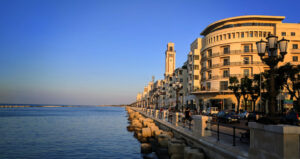PUGLIA AGRITOUR: Polignano, Alberobello e Ostuni
180,00 €
Out of stock
Waiting list : Email me when available again!
Description
AGRONOMIC AND CULTURAL TOUR – ITRIA VALLEY (Bus tour) – September 25
Route: Bari → Polignano a Mare → Ostuni → Martina Franca → Alberobello → Bari
Schedule: 09:00 AM – 07:00 PM
Bilingual guide (Italian/English)
Focus: Agriculture, landscape, cultural heritage
09:00 – Departure from Bari
-
Welcome aboard and introduction to the rural landscape of Puglia
-
Presentation of the itinerary with maps and handouts
-
Overview: ancient olive groves, dry-stone architecture, crop biodiversity
09:45 – Polignano a Mare
A pearl of the Adriatic coast, Polignano is perched on dramatic limestone cliffs and offers breathtaking views of the sea. Its whitewashed old town, with narrow alleys and panoramic terraces, is a maze of poetry and light. The sea caves carved into the rock below are a geological wonder. Polignano is also the birthplace of Domenico Modugno, whose statue overlooks the sea in a gesture of flight. Small gardens and terraces cling to the cliffs, demonstrating centuries-old resilience in coastal agriculture. Visitors are enchanted by the mix of sea, stone, and sky. This town offers a powerful first impression of Puglia’s coastal identity.
Highlights:
-
Lama Monachile, panoramic balconies, sea caves
-
Statue of Domenico Modugno, white historic center
Agriculture & landscape:
-
Terraced gardens and cliffside cultivation: figs, herbs, vines
11:15 – Ostuni
Nicknamed the “White City” for its dazzling limewashed houses, Ostuni rises on a hill overlooking the Adriatic and the Itria Valley. The old town is a labyrinth of winding alleys, stairways, arches, and hidden courtyards. Its 15th-century cathedral, with its large rose window, is a rare blend of Gothic and Romanesque styles. From panoramic terraces, you can admire the vast plain of ancient olive trees—living monuments of Mediterranean agriculture. Ostuni is both refined and rural, a city of noble façades and peasant roots. It also serves as a hub for organic farming and landscape preservation. A place where stone and sap tell stories.
Highlights:
-
Cathedral of Santa Maria Assunta, Scoppa Arch, panoramic viewpoints
-
Historical center with Mediterranean maze-like streets
Agriculture & landscape:
-
Monumental olive groves, native cultivars (Ogliarola, Cellina)
-
Traditional pruning and biodiversity conservation
13:30 – Lunch at masseria
Local food & experience:
-
Traditional Apulian lunch: Capocollo IGP, seasonal vegetables, local wines
-
Optional guided visit of the farm: olive groves, wine cellar, garden
15:50 – Alberobello
A symbol of rural Puglia and a UNESCO World Heritage Site, Alberobello is a fairy-tale village made up of hundreds of trulli—cone-roofed dry-stone houses unique in the world. Wandering through the Rione Monti and Aia Piccola districts feels like stepping into another time. Each trullo is different, often adorned with mystical symbols, flowers, and stone textures. Alberobello showcases spontaneous architecture perfectly adapted to the local karst terrain. These were homes of farmers and artisans, blending living and working spaces. It’s a powerful example of how agriculture, architecture, and cultural identity can coexist in harmony.
Highlights:
-
Trulli of Rione Monti and Aia Piccola, Church of St. Anthony
-
Trullo museum, artisan shops, free time
Agriculture & rural heritage:
-
Trulli as multifunctional rural spaces
-
Water collection in karst soil, dry gardens, stone-based agriculture
19:00 – Return to Bari
-
Farewell, final thoughts and distribution of informative materials:
-
Landscape maps, agricultural biodiversity handouts, local project contacts
-




























Reviews
There are no reviews yet.